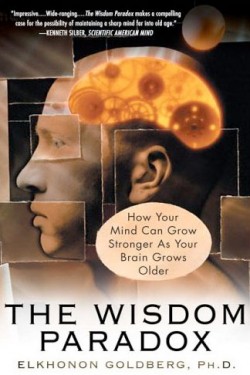
In THE WISDOM PARADOX, world-renowned neuropsychologist Elkhonon Goldberg argues that although some mental abilities (such as recent-memory recall) decline as the mind enters the autumn season of our lifespan and we increasingly experience ‘senior moments’, the brain actually becomes more powerful in its ability to recognize patterns. As a result, we are able to make decisions at more intuitive and effective levels — a late-emerging mental strength he terms ‘wisdom’. In lively, accessible prose, Goldberg delves into the mechanisms of the mind, outlining how the elegant structures of the brain develop and change over the course of a lifetime. Drawing on recent and historical examples of leaders and artists who achieved their greatest successes late in life — from Goethe to Ronald Reagan — Goldberg illustrates the effects of an emerging scientific understanding of the biology of wisdom. Most provocatively, he outlines how a ‘cognitive fitness’ programme can both curtail the negative mental effects of ageing and enhance our decision-making powers. Insightful and inspiring, THE WISDOM PARADOX is a groundbreaking look into our mental machinery that will change the way you think about ageing — and about thinking.
The possibilities of cognitive decline and dementia are among the most frightening aspects of aging. But according to New York University neuropsychologist Elkhonon Goldberg, brains get better in key respects as they get older. Moreover, he argues in The Wisdom Paradox, people can do much to ward off the debilities associated with aging. The brain’s capacity for pattern recognition is central to Goldberg’s premise. Moving through middle age and beyond, the brain develops a vast store of “generic memories”—knowledge of the shared patterns in events or things. This reservoir gives older people an improved ability to size up situations and solve problems without going through the step-bystep assessments a younger person might need. Such pattern recognition underlies competence and expertise and can compensate for age-related declines in attention or memory. Pattern recognition can even amount to “wisdom”—basically, knowing what to do. The author cites various elderly achievers to demonstrate that mental vigor can persist late in life. He notes that sculptor Eduardo Chillida retained formidable abilities even as his Alzheimer’s disease progressed. Delving into the relevant neurobiology, Goldberg points to a growing body of evidence that the brain’s left hemisphere is oriented toward familiar patterns, whereas the right hemisphere focuses on novelty. He argues that this dichotomy is more important than nuts-and-bolts partitions, such as the left hemisphere handling language while the right handles spatial reasoning. This maturation of mind means that the left hemisphere becomes increasingly important over a person’s lifetime. Moreover, the brain is shaped by how it is used. For instance, musicians who practice consistently develop a larger Heschl’s gyrus, an area involved in processing sound. And contrary to onetime scientific belief, the brain forms new neurons throughout adulthood. Through such observations, Goldberg emphasizes the importance of maintaining an active mind as a defense against mental decline. Though not a new idea, Goldberg impressively fits it into a wide- ranging picture of the aging brain. He speculates, for example, that art serves a central societal function in boosting mental acumen. He also outlines a “cognitive exercise program” he runs in which participants engage in computer-based exercises. The discussion here would have benefited from home-based exercises readers might try. Altogether, The Wisdom Paradox makes a compelling case for the possibility of maintaining a sharp mind far into old age. The book merits attention from the old and not so old alike. — KENNETH SILBER, SCIENTIFIC AMERICAN MIND
Available on:
Amazon
Pub. Date: February 2006 | Publisher: Penguin Group | ISBN-10: 1592401872 | ISBN-13: 9781592401871






